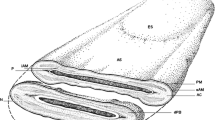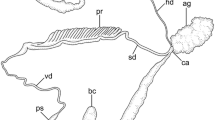Abstract
OOGENESIS studies have revealed that the Golgi bodies may have a variety of shapes ranging from a granule and a vesicle to a typical dictyosome1,2. We have always been faced with the question whether these shapes are fixed or whether one could be derived from the other. Scattered in the literature on spermatogenesis3 and secretory phenomena4,5 we also find batonettes described with double chromophilic rims. If these double-rimmed batonettes have a real existence, what is their relation to the other shapes of the apparatus? From the evidence at our disposal we feel that these types of batonettes could be derived from the vesicular Golgi bodies, the vesicles themselves being derived from granules.
Similar content being viewed by others
References
L. A. Harvey, Proc. Roy. Soc., B, 107, 417 (1931).
V. Nath, Quart. J. Micr. Sci., 73, 477 (1930).
R. H. Bowen, Biol. Bull., 39, 316 (1920).
R. H. Bowen, Quart. J. Micr. Sci., 70, 75, 193, 395, 419 (1926).
R. H. Bowen, Quart. J. Micr. Sci., 70, 75, 193, 395, 419 (1926).
Hirschler, J. Arch. Mikr. Anat., 91, 140 (1918).
Author information
Authors and Affiliations
Rights and permissions
About this article
Cite this article
SUBRAMANIAM, M., AIYAR, R. Two Methods of Formation of Dictyosomes from Vesicular Golgi Bodies. Nature 137, 830–831 (1936). https://doi.org/10.1038/137830b0
Issue Date:
DOI: https://doi.org/10.1038/137830b0
- Springer Nature Limited
This article is cited by
-
Studies on the structure of the Golgi apparatus
Proceedings / Indian Academy of Sciences (1938)
-
An analysis of the shape and structure of golgi bodies in the eggs of invertebrates with a note on the probable modes of origin of the golgi network
Proceedings / Indian Academy of Sciences (1937)





